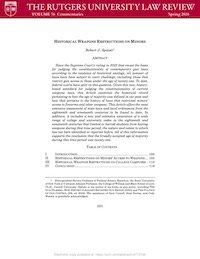By Robert J. Spitzer
Since the Supreme Court’s ruling in 2022 that recast the basis for judging the constitutionality of contemporary gun laws according to the existence of historical analogs, all manner of laws have been subject to court challenge, including those that restrict gun access to those under the age of twenty-one. To date, federal courts have split on this question. Given this new, history-based standard for judging the constitutionality of current weapons laws, this article examines the historical record pertaining to how the age of majority was defined in our past and how that pertains to the history of laws that restricted minors’ access to firearms and other weapons. This article offers the most extensive assessment of state laws and local ordinances from the eighteenth and nineteenth centuries to be found to date. In addition, it includes a new and extensive excavation of a wide range of college and university codes in the eighteenth and nineteenth centuries that limited or barred students from having weapons from that time period, the nature and extent to which has not been identified or reported before. All of this information supports the conclusion that the broadly accepted age of majority during this time period was twenty-one.
Rutgers Law Review, Vol. 76, 2024


